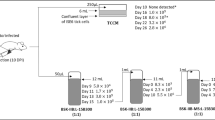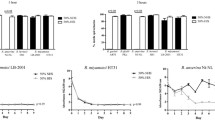Abstract
Isolation and in vitro cultivation of Borrelia burgdorferi were first accomplished from Ixodes dammini ticks by Burgdorfer et al. (1982) and from patients by Benach et al. (1983) and Steere et al. (1983) in the Unites States. In Europe, identical microorganisms were detected and isolated from I. ricinus by Burgdorfer et al. (1983) and Barbour et al. (1983a) respectively. Isolates from patients were subsequently accomplished by Ackermann et al. (1984), Asbrink (1985), Asbrink et al. (1984) and Preac-Mursic et al. (1984). An important contribution had earlier been made by Kelly, who, in 1971 described a new medium permitting the cultivation of B. hermsii and other borreliae. Later on, Kelly’s medium was repeatedly modified especially for the cultivation of B. burgdorferi. The ability to grow B. burgdorferi in vitro has greatly facilitated studies concerning its morphological and biological characteristics.
Access this chapter
Tax calculation will be finalised at checkout
Purchases are for personal use only
Preview
Unable to display preview. Download preview PDF.
Similar content being viewed by others
References
Ackermann R, Kabatzki J, Boisten HP, Steere AC, Grodzicki RL, Härtung S, Runne U (1984) Spirochäten-Ätiologie der Erythema-chronicum-migrans-Krankheit. Dtsch Med Wochenschr 109:92–97
Anderson JF, Magnarelli LA, LeFebvre RB, Andreadis TG, McAnich JB, Perng GC, Johnson RC (1989) Antigenically variable Borrelia burgdorferi isolated from cottontail rabbits and Ixodes dentatus in rural and urban areas. J Clin Micobiol. 27:13–20
Asbrink E (1985) Erythema chronicum migrans Afzelius and acrodermatitis chronica atrophicans. Early and late manifestations of Ixodes ricinus-borne Borrelia spirochetes. Akademisk Avhandling, Stockholm
Asbrink E, Hederstedt B, Hovmark A (1984) The spirochetal etiology of erythema chronicum migrans Afzelius. Acta Derm Venereol (Stockh) 64:291–295
Barbour AG (1988) Plasmid analysis of Borrelia burgdorferi, the Lyme borreliosis agent. J Clin Microbiol 26:475–478
Barbour AG, Garon CF (1987) Linear plasmids of the bacterium Borrelia burgdorferi have covalently closed ends. Science 237:409–411
Barbour AG, Hayes SF (1986) Biology of Borrelia species. Microbiol Ref 4 (50) 381–400
Barbour AG, Schrumpf ME (1986) Polymorphisms of major surface proteins of Borrelia burgdorferi. Zentralbl Bakteriol Hyg (A) 263:83–91
Barbour AG, Burgdorfer W, Hayes SF, Péter O, Aeschlimann A (1983a) Isolation of a cultivable spirochete from Ixodes ricinus ticks of Switzerland. Curr Microbiol 8:123–126
Barbour AG, Tessier SL, Todd WJ (1983b) Lyme disease spirochetes and ixodid tick spirochetes share a common surface antigenic determinant defined by a monoclonal antibody. Infect Immun 41:795–804
Barbour AG, Tessier SL, Hayes SF (1984) Variation in a major surface protein of Lyme disease spirochetes. Infect Immun 45:94–100
Barbour AG, Hayes SF, Heiland RA, Schrumpf ME, Tessier SL (1986) A Borrelia-specific monoclonal antibody binds to a flagellar epitope. Infect Immun 52:549–554
Baril C, Richaud C, Baranton G, Saint Girons J (1989) Linear chromosome of Borrelia burgdorferi. Res Microbiol 140:507–516
Barthold SW, Moody KD, Terwilliger JA, Duray PH, Jacoby RO, Steere AC (1988) Experimental Lyme arthritis of rats infected with Borrelia burgdorferi. J Infect Dis 157:842–846
Beck G, Habicht GS (1988) Isolation and biological activity of Borrelia burgdoiferi pepti-doglycan. Ann NY Acad Sci 539:365–366
Benach JL, Bosler EM, Hanrahan JP, Coleman JL, Habicht GS, Bost TF, Cameron DJ, Ziegler JL, Barbour AG, Burgdorfer W, Edelman R, Kaslow RA (1983) Spirochetes isolated from the blood of two patients with Lyme disease. N Engl J Med 308:740–742
Bundoc VG, Barbour AG (1989) Clonal polymorphisms of outer membrane protein OspB of Borrelia burgdoiferi. Infect Immun 57:2733–2741
Burgdorfer W (1984) The New Zealand white rabbit. An experimental host for infecting ticks with Lyme disease spirochetes. Yale J Biol Med 57:609–612
Burgdorfer W (1991) Lyme borreliosis - a relapsing fever-like illness? Scand J Infect Dis Suppl 77:17–22
Burgdorfer W, Gage KL (1987) Susceptibility of the hispid cotton rat (Sigmodon hispidus) to the Lyme disease spirochete (Borrelia burgdorferi). Am J Trop Med Hyg 37:624–628
Burgdorfer W, Barbour AG, Hayes SF, Benach JL, Grunwaldt E, Davis JP (1982) Lyme disease - a tick-borne spirochetosis? Science 216:1317–1319
Burgdorfer W, Barbour AG, Hayes SF, Péter O, Aeschlimann A (1983) Erythema chronicum migrans - a tick-borne spirochetosis. Acta Trop (Basel) 40:17–83
Burgess EC (1986) Experimental inoculation of dogs with Borrelia burgdorferi. Zentralbl Bakteriol (A) 263:49–54
Cluss RG, Boothby JT (1990) Thermoregulation of protein synthesis in Borrelia burgdorferi. Infect Immun 58:1038–1042
Coleman JL, Benach JL, Beck G, Habicht GS (1986) Isolation of outer envelope from Borrelia burgdorferi. Zentralbl Bakteriol Hyg (A) 263:123–126
Elwell LP, Shipley PI (1980) Plasmid-mediated factors associated with virulence of bacteria to animals. Annu Rev Microbiol 34:465–496
Ferdows MS, Barbour AG (1989) Megabase-sized linear DNA in the bacterium Borrelia burgdorferi, the Lyme disease agent. Proc Natl Acad Sci USA 86:5969–5973
Fumarola D, Munno J, Marcuccio C, Miragliotta G (1986) Endotoxicity associated with the Lyme disease Borrelia: recent findings. Microbiologica 9:249–252
Garon CL, Dorward DW, Lubke LL, Corwin MD (1990) Ultrastructural detection of a DNA- containing compartment on the surface of Borrelia burgdorferi cells (poster). In: 4th international conference on Lyme borreliosis, Stockholm
Gassmann GS, Kramer M, Göbel UB, Wallich R (1989) Nucleotide sequenze of a gene encoding theB. burgdorferi flagellin. Nucleic Acids Res 17:3590
Goodman JL, Jurkovich P, Kramber JM, Johnson RC (1991) Molecular detection of persistent Borrelia burgdorferi in the urine of patients with active Lyme disease. Infect Immun 59:269–278
Habicht GS, Beck G, Benach JL, Coleman JL (1986) Borrelia burgdorferi lipopolysaccharide and its role in the pathogenesis of Lyme disease. Zentralbl Bakteriol Hyg (A) 263:137–141
Hansen K, Bangsborg JM, Fjordvang H, Pedersen NS, Hindersson P (1988) Immunochemical characterization and isolation of the gene for a Borrelia burgdorferi immunodominant 60- kilodalton antigen common to a wide range of bacteria. Infect Immun 56:2047–2053
Holt JG, Krieg NR (eds) (1984) Bergey’s manual of systematic bacteriology, vol 1. Williams and Wilkins, Baltimore
Hyde FW, Johnson RC (1984) Genetic relationship of Lyme disease spirochetes toBorrelia, Treponema, andLeptospira spp. J Clin Microbiol 20:151–154
Hyde FW, Johnson RC (1988) Characterization of a circular plasmid from Borrelia burgdorferi etiologic agent of Lyme disease. J Clin Microbiol 26:2203–2205
Johnson RC, Hyde FW, Rumpel CM (1984a) Taxonomy of the Lyme disease spirochetes. Yale J Biol Med 57:79–87
Johnson RC, Schmid GP, Hyde FW, Steigerwalt AG, Brenner DJ (1984b) Borrelia burgdorferi sp.nov: etiologic agent of Lyme disease. Int J Syst Bacteriol 34:496–497
Johnson RC, Marek N, Kodner C (1984c) Infection of Syrian hamsters with Lyme disease spirochetes. J Clin Microbiol 20:1099–1101
Johnson RC, Kodner C, Russel M, Duray PH (1988) Experimental infection of the hamster with Borrelia burgdorferi. Ann NY Acad Sci 539:258–263
Kelly RT (1971) Cultivation of Borrelia hermsii. Science 173:443–444
Kelly RT (1976) Cultivation and physiology of relapsing fever borreliae. In: Johnson RC (ed) The biology of parasitic spirochetes. Academic, New York p 87
Kornblatt AN, Steere AC, Brownstein DG (1984) Experimental Lyme disease in rabbits: spirochetes found in erythema migrans and blood. Infect Immun 46:220–223
Kurtti TJ, Munderloh UG, Johnson RC, Ahlstrand GG (1987) Colony formation and morphology in Borrelia burgdorferi. J Clin Microbiol 25:2054–2058
Livermore BP, Bey RF, Johnson RC (1978) Lipid metabolism of Borrelia hermsii. Infect Immun 20:215–220
Persing DH, Telford SR, Spielman A, Barthold SW (1990) Detection of Borrelia burgdorferi infection inIxodes dammini ticks with the polymerase chain reaction. J Clin Microbiol 28:566–572
Pillot Z (1965) Contribution à 1’ étude du genre Treponema: structure anatomique et antige- nique. Thesis, Paris
Postic D, Edlinger C, Rauchaud C, Grimont F, Dufresne Y, Perolat P, Baranton G, Grimon PAD (1990) Two genomic species in Borrelia burgdorferi. Res Microbiol 141:465–475
Preac-Mursic V, Schierz G, Pfister-HW, Einhäupl K, Wilske B, Weber K (1984) Isolierung einer Spirochäte aus Liquor cerebrospinalis bei Meningoradikulitis Bannwarth. Munch Med Wochenschr 126:275–276
Preac-Mursic V, Wilske B, Schierz G (1986) European Borrelia burgdorferi isolated from humans and ticks: culture conditions and antibiotic susceptibility. Zentralbl Bakteriol Hyg (A) 263:112–118
Preac-Mursic V, Wilske B, Schierz G, Holmburger M, Süß E (1987) In vitro and in vivo susceptibility of Borrelia burgdorferi. Eur J Clin Mibrobiol 6:424–426
Preac-Mursic V, Patsouris E, Wilske B, Reinhardt S, Groß B (1990) Persistence of Borrelia burgdorferi and histopathological alterations in experimentally infected gerbils. Comparison with histopathological findings in human Lyme disease. Infection 18:1–10
Preac-Mursic V, Wilske B, Reinhardt S (1991) Culture of Borrelia burgdorferi on six solid media. Eur J Clin Microbiol 10:1076–1079
Rosa PA, Schwan TG (1991) A specific and sensitive assay for the Lyme disease spirochete Borrelia burgdorferi using polymerase chain reaction. J Infect Dis 160:1018–1029
Rosa PA, Hogan D, Schwan TG (1991) Polymerase chain reaction analyses indentify two distinct classes of Borrelia burgdorferi. J Clin Microbiol 29:524–532
Schaible UE, Kramer MD, Museteanu C, Zimmer G, Mossmann H, Simon MM (1989) The severe combined immunodeficiency (SCID) mouse. A laboratory model for analysis of Lyme arthritis and carditis. J Exp Med 170:1427–1431
Schmid GP, Steigerwalt AG, Johnson SE, Barbour AG, Steere AC, Robinson JM, Brenner DJ (1984) DNA characterization of the spirochete that causes Lyme disease. J Clin Microbiol 20:155–158
Schwan TG, Barbour AG (1988) Efficacy of nucleic acid hybridization probes for the detection and identification of Borrelia burgdorferi. Ann NY Acad Sci 539:419–421
Schwan TG, Burgdorfer W (1987) Antigenic changes of Borrelia burgdorferi as a result of in vitro cultivation. J Infect Dis 156:852–853
Schwan TG, Burgdorfer W, Garon CF (1988a) Changes in infectivity and plasmid profile of the Lyme disease spirochete, Borrelia burgdorferi, as a result of in vitro cultivation. Infect Immun 56:1831–1836
Schwan TG, Burgdorfer W, Schrumpf ME, Karstens RH (1988b) The urinary bladder, a consistent source of Borrelia burgdorferi in experimentally infected white-footed mice (Peromys- cus leucopus). J Clin Microbiol 26:893–895
Simpson WJ, Burgdorfer W, Schrumpf ME, Karstens RH, Schwan TG (1991) Antibody to a 39- KilodaltonBorrelia burgdorferi antigen (P39) as a marker for infection in experimentally and naturally inoculated animals. J Clin Microbiol 29:236–243
Stanek G, Burger I, Hirschl A, Wewalka G, Radda IA (1986)Borrelia transfer by ticks during their life cycle. Zentralbl Bakteriol Hyg (A) 263:29–33
Steere AC, Grodzicki RL, Kornblatt AN, Craft JE, Barbour AG, Burgdorfer W, Schmid GP, Johnson E, Malawista S (1983) The spirochetal etiology of Lyme disease. N Engl J Med 308:733–740
Stoenner HG (1974) Biology of Borrelia hermsii in Kelly medium. Appl Microbiol 28:540–543
Takayama K, Rothenberg RJ, Barbour AG (1987) Absence of lipopolysaccharide in the Lyme disease spirochete, Borrelia burgdorferi. Infect Immun 55:2311–2313
Wilske B, Preac-Mursic V, Schierz G (1985) Antigenic heterogeneity of European Borrelia burgdorferi strains isolated from patients and ticks. Lancet I: 1099
Wilske B, Preac-Mursic B, Schierz G, von Busch K (1986) Immunochemical and immunological analysis of EuropeanBorrelia burgdorferi strains. Zentral Bakteriol Hyg (A) 263:92–102
Wilske B, Preac-Mursic V, Schierz G, Kühbeck R, Barbour AG, Kramer M (1988) Antigenic variability of Borrelia burgdorferi. Ann NY Acad Sci 539:126–143
Wilske B, Preac-Mursic V, Fuchs R, Bruckbauer H, Hofmann A, Zumstein G, Jauris S, Soutschek E, Motz M (1990) Immundominant proteins of Borrelia burgdorferi; implications for improving serodiagnosis of Lyme borreliosis. In: Neu HC (eds) New antibacterial strategies. Churchill Livingstone, London
Wilske B, Anderson JF, Barbour AG, Hovind-Hougen K, Johnson RC, Preac-Mursic V (1991) Taxonomy of Borrelia spp. Scand J Infect Dis Suppl 77:108–129
Editor information
Editors and Affiliations
Rights and permissions
Copyright information
© 1993 Springer-Verlag Berlin Heidelberg
About this chapter
Cite this chapter
Preac-Mursic, V., Wilske, B. (1993). Biology of Borrelia burgdorferi . In: Weber, K., Burgdorfer, W., Schierz, G. (eds) Aspects of Lyme Borreliosis. Springer, Berlin, Heidelberg. https://doi.org/10.1007/978-3-642-77614-4_4
Download citation
DOI: https://doi.org/10.1007/978-3-642-77614-4_4
Publisher Name: Springer, Berlin, Heidelberg
Print ISBN: 978-3-642-77616-8
Online ISBN: 978-3-642-77614-4
eBook Packages: Springer Book Archive




